Authors
B. Ling, N. Authier, D. Balayssac, A. Eschalier, F. Coudore.
Lab
Université Clermont1, Faculté de Pharmacie, Laboratoire de Toxicologie, Clermont-Ferrand, France.
Journal
Pain
Abstract
We describe an animal model of nociceptive sensory neuropathy induced by repeat intravenous administration of oxaliplatin in which treated animals partly reproduce the characteristic pain symptoms in oxaliplatin-treated patients. We tested the ability of 1, 2 and 4 mg/kg oxaliplatin doses injected twice-weekly for four-and-a-half consecutive weeks to induce a nociceptive peripheral neuropathy in male Sprague–Dawley rats. The behavioral assessment revealed cold allodynia (10 °C) and hyperalgesia (4 °C) symptoms associated with a mechanical allodynia. The rats maintained a good general clinical status without motor dysfunction. The 2 mg/kg oxaliplatin dose and the tail-immersion test in cold water (10 °C) were selected to compare pharmacological sensitivity between single administered drugs as morphine, lidocaine, carbamazepine, gabapentin and repeated administration of drugs as clomipramine, venlafaxine, calcium and magnesium solutions. Magnesium solution (90 mg/kg) and venlafaxine (7.5 mg/kg) administration induced an antinociceptive effect whereas gabapentin (300 mg/kg), clomipramine (2.5 mg/kg) and lidocaine (3 and 6 mg/kg) only induced an antiallodynic effect.
BIOSEB Instruments Used:
Grip strength test (BIO-GS3)

 Douleur - Allodynie/Hyperalgésie Thermique
Douleur - Allodynie/Hyperalgésie Thermique Douleur - Spontanée - Déficit de Posture
Douleur - Spontanée - Déficit de Posture Douleur - Allodynie/Hyperalgésie Mécanique
Douleur - Allodynie/Hyperalgésie Mécanique Apprentissage/Mémoire - Attention - Addiction
Apprentissage/Mémoire - Attention - Addiction Physiologie & Recherche Respiratoire
Physiologie & Recherche Respiratoire
 Douleur
Douleur Système Nerveux Central (SNC)
Système Nerveux Central (SNC)  Neurodégénérescence
Neurodégénérescence Système sensoriel
Système sensoriel Système moteur
Système moteur Troubles de l'humeur
Troubles de l'humeur Autres pathologies
Autres pathologies Système musculaire
Système musculaire Articulations
Articulations Métabolisme
Métabolisme Thématiques transversales
Thématiques transversales SFN2024: Venez rencontrer notre équipe sur le stand 876 à Chicago
SFN2024: Venez rencontrer notre équipe sur le stand 876 à Chicago 